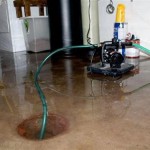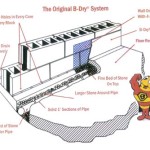Basement Floor Drain Backing Up After Shower: Causes, Solutions, and Prevention
A basement floor drain backing up after a shower is a common plumbing problem that can lead to significant inconvenience and potential property damage. Understanding the underlying causes, implementing effective solutions, and adopting preventive measures is crucial for homeowners to maintain a healthy and functional plumbing system in their basements. This article will delve into the reasons behind this issue, explore various remediation strategies, and outline preventative steps to mitigate the risk of future occurrences.
The functionality of a basement floor drain is primarily to manage excess water, whether from appliance leaks, flooding, or drainage from other sources. When this drain backs up, particularly after shower use, it signals an obstruction or overload within the drainage system. This situation necessitates prompt attention to prevent further complications like water damage, mold growth, and unpleasant odors.
Understanding the Common Causes
The primary reason a basement floor drain backs up after a shower links to the drain system's capacity to handle the water volume or the presence of obstructions. Investigating potential causes includes identifying the source of the blockage to apply the correct solution. Several factors can contribute to this issue, each requiring a different approach for resolution.
One of the most frequent culprits is a clogged drain line. Over time, hair, soap scum, dirt, and other debris can accumulate within the drainpipes, gradually reducing the pipe's internal diameter. This constriction restricts water flow, leading to backflow when the volume of wastewater exceeds the drain’s reduced capacity. Showers, which release a significant amount of water relatively quickly, are particularly prone to exacerbating this issue.
Another possible cause is a blockage in the main sewer line. The basement floor drain is usually connected to the main sewer line that carries waste from the entire house to the municipal sewer system or a private septic tank. If the main line is blocked, wastewater from all fixtures, including showers, sinks, and toilets, will back up into the lowest drain, which is often the basement floor drain. This type of backup is usually accompanied by other symptoms, such as slow draining in multiple fixtures throughout the house.
Furthermore, issues within the septic system can also trigger basement floor drain backups. In homes with septic systems, a full or malfunctioning septic tank can prevent wastewater from draining properly. The resulting backpressure can then manifest as a backup in the basement floor drain, particularly after high-water-use activities like showering or doing laundry.
Tree root infiltration is another common, and often overlooked, contributor to drain line blockages. Tree roots are drawn to the moisture and nutrients within sewer lines. Over time, they can penetrate the pipes, causing significant obstructions. These roots can expand within the pipes, substantially reducing flow capacity or even completely blocking the drain. This issue is more prevalent in older homes with clay or cast iron pipes, which are more susceptible to cracks and leaks.
Finally, inadequate plumbing ventilation can also contribute to backflow issues. Plumbing systems are designed with vent pipes that allow air to enter the drain lines, which helps maintain proper water flow. If these vents are blocked, it can create a vacuum effect that slows down drainage or even causes water to back up. Blockages in the vent pipes might result from bird nests, debris accumulation, or structural damage to the vent system.
Methods for Resolving a Backed-Up Basement Drain
Addressing a basement floor drain backup requires a systematic approach, starting with identifying the likely cause and then implementing the appropriate solution. The methods used to resolve the problem range from simple DIY techniques to professional plumbing interventions.
The first step in tackling a minor clog is often using a plunger. A standard cup plunger can be effective for dislodging minor obstructions close to the drain opening. The plunger creates suction that can break up the clog and allow water to flow freely. It's essential to ensure there is enough water in the drain to create a good seal with the plunger.
For more stubborn clogs, a drain snake or auger may be necessary. These tools are designed to reach further into the drainpipe and break up or retrieve the obstruction. A hand-operated drain snake is appropriate for smaller clogs, while a motorized auger might be required for more severe blockages located deeper within the drain line. When using a drain snake, it's important to rotate it carefully to avoid damaging the pipes.
Chemical drain cleaners are also available, but they should be used with caution. While these products can dissolve certain types of clogs effectively, they can also be corrosive and damage the pipes, especially older ones. Moreover, some chemical drain cleaners can be harmful to the environment and pose a health risk if not used properly. Alternative, less aggressive, solutions, such as a mixture of baking soda and vinegar followed by hot water, can sometimes be effective for dissolving minor clogs without the risk of damage.
If the problem stems from a suspected blockage in the main sewer line, professional plumbing assistance is often required. Plumbers have specialized equipment, such as video cameras and high-pressure water jets (hydro-jetting), to diagnose and clear main line obstructions. Video camera inspection allows the plumber to visually inspect the inside of the pipes to identify the exact location and nature of the blockage. Hydro-jetting uses high-pressure water to blast away accumulated debris and tree roots, effectively cleaning the pipe walls and restoring full flow capacity.
In cases where tree root infiltration is suspected, a professional plumber may use a rooter machine to cut through the roots and clear the drain line. However, this is often a temporary solution, as the roots are likely to grow back. In such situations, more permanent solutions, such as replacing the damaged section of the pipe with root-resistant materials or installing a chemical root barrier, may be necessary.
If the backup is related to a septic system issue, the septic tank will need to be inspected and potentially pumped. A full septic tank prevents wastewater from draining properly, which can lead to backups in the house. Additionally, a malfunctioning septic system can contaminate the surrounding soil and water supply, posing serious environmental and health risks. Regular septic tank maintenance, including periodic inspections and pumping, is essential for preventing these issues.
Preventative Measures for Avoiding Future Backups
The best way to deal with a basement floor drain backup is to prevent it from happening in the first place. Implementing preventive measures can significantly reduce the risk of clogs and backups, safeguarding the plumbing system and minimizing the potential for water damage. Regular maintenance and responsible drain usage habits are crucial in this regard.
One of the simplest and most effective preventive measures is to regularly flush the drain with hot water. Hot water helps to dissolve grease and soap scum that can accumulate and contribute to clogs. Pouring a kettle of boiling water down the drain once a week can help keep the drain lines clear.
Installing drain screens or strainers in showers, sinks, and floor drains is another simple yet effective way to prevent clogs. These screens catch hair, soap scum, and other debris before they enter the drainpipes, significantly reducing the likelihood of blockages. Cleaning these screens regularly is essential to maintain their effectiveness.
Avoiding the disposal of grease, oil, and food scraps down the drain is crucial. These materials can solidify and accumulate inside the drainpipes, leading to significant clogs over time. Instead, grease and oil should be collected in a separate container and disposed of properly, while food scraps should be thrown away or composted.
Regularly inspecting plumbing vents can help ensure proper drainage. Make sure that the vent pipes are free from obstructions such as bird nests, leaves, and other debris. If you suspect a blockage in the vent system, consider contacting a professional plumber to inspect and clear the vents.
For homes with septic systems, regular septic tank maintenance is essential. This includes periodic inspections to monitor the tank's condition and pumping the tank every three to five years, depending on the size of the tank and the number of occupants in the household. Proper septic tank maintenance can prevent backups and extend the life of the system.
Finally, consider scheduling periodic professional drain cleaning. A professional plumber can use specialized equipment, such as hydro-jetting, to thoroughly clean the drain lines and remove any accumulated debris or buildup. This can help prevent clogs and ensure that the plumbing system is functioning optimally.
By understanding the causes of basement floor drain backups, implementing appropriate solutions, and adopting preventive measures, homeowners can maintain a healthy and functional plumbing system, avoiding the inconvenience and potential damage associated with this common plumbing issue. Regular maintenance and vigilance are key to preventing future occurrences and ensuring the longevity of your home's plumbing infrastructure.

Why Does My Floor Drain Back Up Structure Tech Home Inspections

Why Does My Floor Drain Back Up Structure Tech Home Inspections

Floor Drain Backing Up In Basement

Sewer Backup Basement Drain Flood Causes Cyclone Valves

Basement Drain Backing Up Here S What To Do Right Now Servicemaster

Emergency Plumbing Services Guelph Clogged Floor Drain Solutions

Basement Drain Backing Up In Winter Top Causes Solutions

How To Fix Basement Floor Drain Backing Up Avalon Home Inspections

Basement Drain Backing Up Here S What To Do Right Now Servicemaster

Why Did My Basement Floor Drain Back Up 1 Tom Plumber







